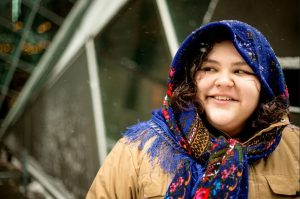 By Gemma Dingwall
By Gemma Dingwall
Like all interns participating in McGill’s Human Rights Internship program in 2020, what I was expecting my internship to look like this summer is certainly quite different from the reality.
This summer I am working remotely for the Department of Justice and Correctional Services of the Cree Nation. Prior to the restrictions imposed on people entering the region due to COVID-19, the plan was for me to complete my internship in one of the communities in the region. Although my work and assignments were adapted to remote work, there is one major component missing from my internship: the ability to learn and experience the Cree culture as well as the northern lifestyle. So I decided I had to do the next best thing: find ways to experience Cree culture here in Montreal.
The following is a proposed weekend itinerary of how one can learn about the way of life in the Cree Nation. I hope you join me in using some of these resources to learn more about the region.

Friday night: after a long week at work, it is time to settle in for a movie night. For this, I propose Reel Injun. This documentary focuses on the portrayal of Indigenous people in Hollywood films. It addresses stereotypes and inaccuracies in both historical and contemporary films. It is available from sundancenow.com. The film is directed by Neil Diamond, who is an award-winning filmmaker from Waskaganish, a community within the region.
Saturday morning: Time to get out of the house and enjoy the sunshine. Grab your blanket because it is time to go your nearest park and settle in with the book The Sweet Bloods of Eeyou Istchee: Stories of Diabetes and the James Bay Cree.
This is a collection of true stories about people from the region and their journeys with diabetes. These stories capture the many ways in which colonialism and changes in lifestyle have contributed to the high rates of diabetes in the Cree Nation. They trace the effects of starvation in residential school, racism within the health system, forced community relocation and the ways in which the loss of culture all contribute to diabetes. I highly recommend this book, which can be ordered from sweetbloods.org. Some of the stories are also available in audiobook for free from sweetbloods.org.
Saturday Afternoon: Whatever your favourite mode of exercise is on the weekend, why not play some tunes from Cree artists while you get your sweat on? Angel Baribeau is a musician from the region. Check out one of my favourites of their songs: SAVAGE.
Saturday Night: Time for another Neil Diamond film! The documentary, Inuit Cree Reconciliation films the Inuit and Cree coming together to celebrate 200 years of peace. The film tells stories of the violent clashes between the two groups throughout the 18th century. The film also showcases the beautiful northern landscape.

Sunday Morning: Today, we will head to a museum. The Aanischaaukamikw Cree Cultural Institute is located in Oujé-Bougoumou. This is the newest of the communities in the region, with a population of 900 people. The museum offers virtual exhibits, showcasing artifacts like a bible printed in Cree Syllabics, different furs, arrowheads, etc. There are also several short informational video clips.
Sunday Lunch: Many people in the Cree region continue to enjoy country food. In the early spring, many spend weeks in the bush hunting for goose and in the autumn, they return to the bush for moose. Fishing is a popular pastime throughout the year, including ice fishing in the winter.
Although these foods cannot be experienced in the same fresh way here, there are ways to try Indigenous food in Montreal. For example, the Roundhouse Cafe, which employs Indigenous people who have been out of work or experienced homelessness serves much of its food on bannock. Bannock is certainly popular in the Cree Nation as well. Or if you’re baker, why not try to make your own bannock – there are many recipes online. To remind yourself that in another time, you could be eating fresh fish instead for lunch, watch this video about fishing trips in the region.
Sunday Evening: Labrador tea is a plant that grows in the region but is also available for purchase in Montreal. So why not brew a cup while you settle in to watch my final film recommendation for the weekend. Cree of James Bay documents the Hydroelectric development in James Bay and the impact on the Cree culture. I particularly enjoyed this film because of its ability to capture Cree humour.
Certainly, these virtual options are not a perfect replacement. They will not allow you to experience being surrounded by the Cree language. They will not replace the beauty of the northern landscape. They do not allow you to become accustomed to living two minutes away from everything in your community, but hours away from everything outside of the community. Nevertheless, these resources are a wonderful way to learn more about the region and the Cree way of life.
I hope you joined me in checking out some of them!
